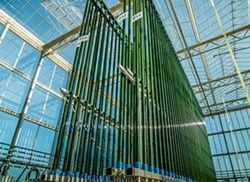SCHOTT Glass Tubing for Algae Production and Wastewater Cleaning

ecoduna’s patented vertical photobioreactor constructed with glass tubes from SCHOTT AG at ecoduna’s plant
Photo by SCHOTT North America, Inc.
Algae production systems are made to run constantly, therefore the tubing must be structurally sound and cannot become opaque or fade. SCHOTT’s glass tubing can withstand hundreds of gallons of water filled with algae over many years and still maintain excellent light transmittance. Research has found that SCHOTT’s glass tubing boasts higher light transmission than polymer tubes while experiencing minimal solar degradation over one year.
Montana-based Clearas Water Recovery, which specializes in wastewater cleaning and recovery, relies on SCHOTT glass tubing in its nutrient recovery system. Clearas Water’s reactors use sunlight and algae’s appetite to remove excess nitrogen and phosphorus from municipal and industrial water supplies before the water is discharged into the environment. The algae, feeding on the surplus of nutrients in tightly controlled, clear glass tubing, can reduce the phosphorus levels in the water by a factor of 10 and the nitrogen levels by a factor of 3; the biomass can be transformed into soil enhancements, fuels, and other products. Because the system is designed to run constantly, Clearas Water uses SCHOTT’s glass tubing, which remains structurally sound and doesn’t degrade in transparency over the span of many years.
ecoduna, which produces biomass from chlorella, spirulina, and other algae, runs a vertical photobioreactor system using SCHOTT’s 65mm DURAN glass tubing. Nutrients are introduced at the base and oxygen disperses from the top. The glass tube system provides superior light dilution and utilization, as well as a large surface-to-volume ratio. ecoduna can cultivate 365 days of the year and the firm expects to replace the tubing once every 50 years. The consistency, longevity, and transparency of the tubes in this vertical photobioreactor help increase output while driving down operating costs.
“Clearas Water has turned to algae to clean and filter wastewater and prevented environment-wrecking algae blooms, like the ones in Lake Erie almost every year. ecoduna has pioneered continuous industrial algae production methods while conserving resources,” said Schultz. “Both companies offer real-life evidence of the unique properties glass tubing brings to algae production, from clarity to strength to longevity to sustainability.”
For more information: http://microsites.schott.com/us-pbr/english/index.html
News Categories
- » NEWS HOME
- » Automation & Robotics
- » Industry 4.0
- » Material Handling
- » Sensors
- » Quality & Testing
- » Machine Vision
- » Laser & Optics
- » Metalworking
- » Motion Control & Drives
- » Hydraulics & Pneumatics
- » Process Industry
- » Renewable Energy
- » Agriculture
- » Home & Office Furniture
- » Environmental Tech









